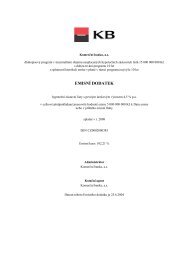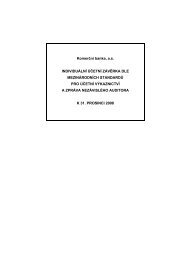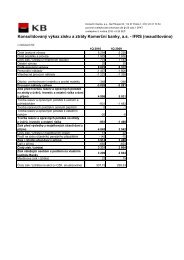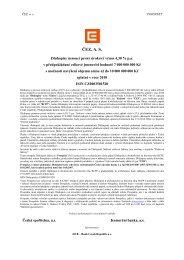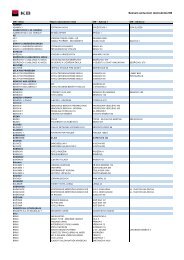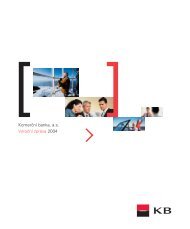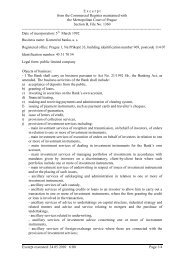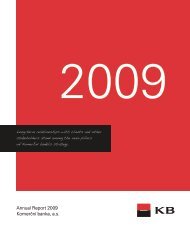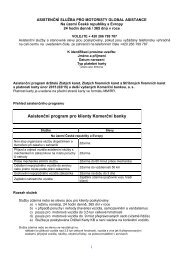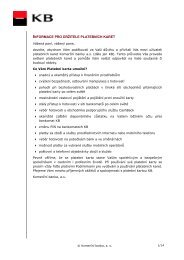KB prezent. angl - Komerční banka
KB prezent. angl - Komerční banka
KB prezent. angl - Komerční banka
Create successful ePaper yourself
Turn your PDF publications into a flip-book with our unique Google optimized e-Paper software.
074 ➔075<br />
Unconsolidated Financial Statements<br />
under CAS<br />
(m) Sale and repurchase agreements<br />
Securities received as collateral under reverse repo transactions are not recognised on the Bank’s balance sheet and are stated at fair<br />
value in off balance sheet accounts. The off balance sheet accounts do not reflect collateral that is subject to a short sale. The reverse<br />
repo is defined as a standard reverse repurchase transaction and also as a borrowing of securities secured by the transfer of financial<br />
assets and a purchase of securities with a concurrently negotiated resale. Securities provided as collateral under repurchase<br />
transactions are retained within the portfolio in which they were carried prior to their being provided in the repurchase transaction.<br />
In regard to the sale of a security acquired as collateral under a reverse repurchase transaction, the Bank recognises in the balance<br />
sheet an amount payable from a security which is remeasured to fair value.<br />
(n) Derivative financial instruments and hedging<br />
In the normal course of business, the Bank enters into contracts for derivative financial instruments which represent a financial<br />
instrument that requires a very low initial investment relative to the nominal value of the contract. The derivative financial instruments<br />
used include interest rate and currency forwards, swaps, options and securities based derivatives. These financial instruments are<br />
used by the Bank for trading and to hedge interest rate risk and currency exposures associated with its transactions in the financial<br />
markets. The Bank also acts as an intermediary provider of these instruments to certain clients.<br />
Derivative financial instruments are initially recognised in the off balance sheet accounts at the value of the underlying instruments<br />
and subsequently are remeasured to their fair value. Fair values are obtained from quoted market prices, discounted cash flow<br />
models and options pricing models as appropriate. All derivatives are carried as assets when fair value is positive and as liabilities<br />
when fair value is negative.<br />
Certain derivatives are embedded in other financial instruments, such as the conversion option in a convertible bond, and are treated<br />
as separate derivatives when their risks and characteristics are not closely related to those of the host contract and the host contract<br />
is not carried at fair value with unrealised gains and losses reported in the profit and loss statement.<br />
Changes in the fair value of derivatives held for trading are included in the profit and loss statement line Net profit or loss on financial<br />
operations.<br />
On the date a derivative contract is entered into, the Bank designates certain derivatives as either (i) a hedge of the fair value of<br />
a recognised asset or liability (fair value hedge) or (ii) a hedge of a future cashflow attributable to a recognised asset or liability,<br />
a forecasted transaction or a firm commitment (cash flow hedge). Hedge accounting is used for derivatives designated in this way<br />
provided certain criteria are met.<br />
On the date a derivative contract is entered into, the Bank designates certain derivatives as hedges which are recognised using<br />
hedging accounting rules provided that the following criteria are met:<br />
(a) The Bank has developed a risk management strategy;<br />
(b) At the inception of the hedge, the hedging relationship is formally documented, the documentation identifies the hedged item and<br />
the hedging instrument, defines the risk that is being hedged and the approach to establishing whether the hedge is effective;<br />
(c) The hedge is effective, that is, if, at inception and throughout the period, changes in the fair value or cash flows of the hedged<br />
item are almost fully offset by changes in the fair value or cash flows of the hedging instrument and the results are within a range<br />
of 80 percent to 125 percent.<br />
Changes in the fair value of derivatives that are designated and qualify as fair value hedges and that prove to be highly effective in<br />
relation to the hedged risk, are recorded in the profit and loss statement along with the corresponding change in fair value of the<br />
hedged asset or liability that is attributable to the specific hedged risk. The ineffective element of the hedge is charged directly to the<br />
profit and loss statement line Net profit or loss on financial operations.<br />
If the hedge no longer meets the criteria for hedge accounting, an adjustment to the carrying value of a hedged interest-bearing<br />
financial instrument is amortised to net profit and loss over the period to maturity.<br />
Changes in the fair value of derivatives that are designated and qualify as cash flow hedges and that prove to be highly effective in<br />
relation to hedged risk, are recognised in the hedging reserve in shareholders’ equity. Amounts deferred in equity are transferred to<br />
the profit and loss statement and classified as revenue or expense in the periods during which the hedged assets and liabilities affect<br />
the profit and loss statement. The ineffective element of the hedge is charged directly to the profit and loss line Net profit or loss on<br />
financial operations.



